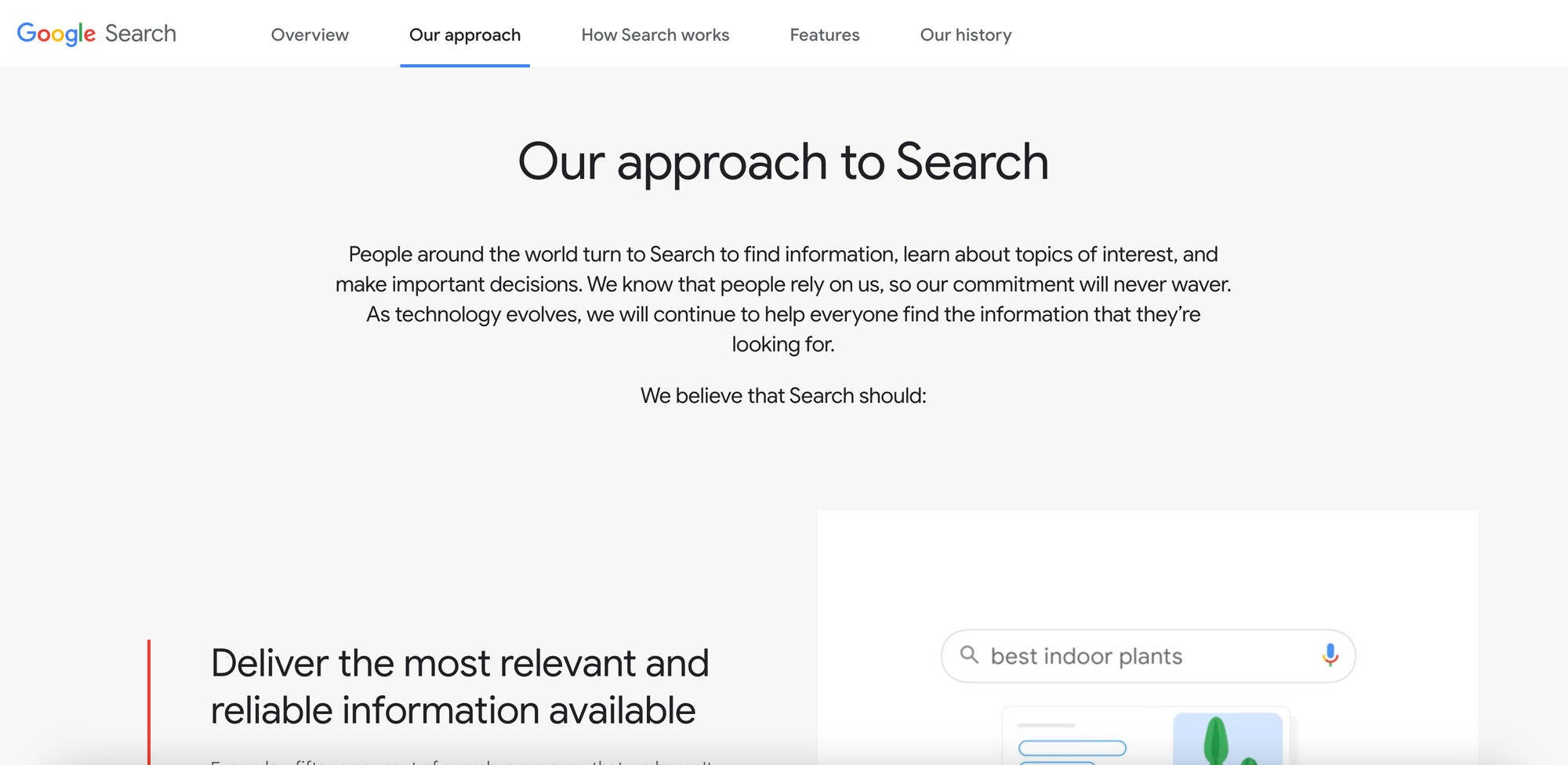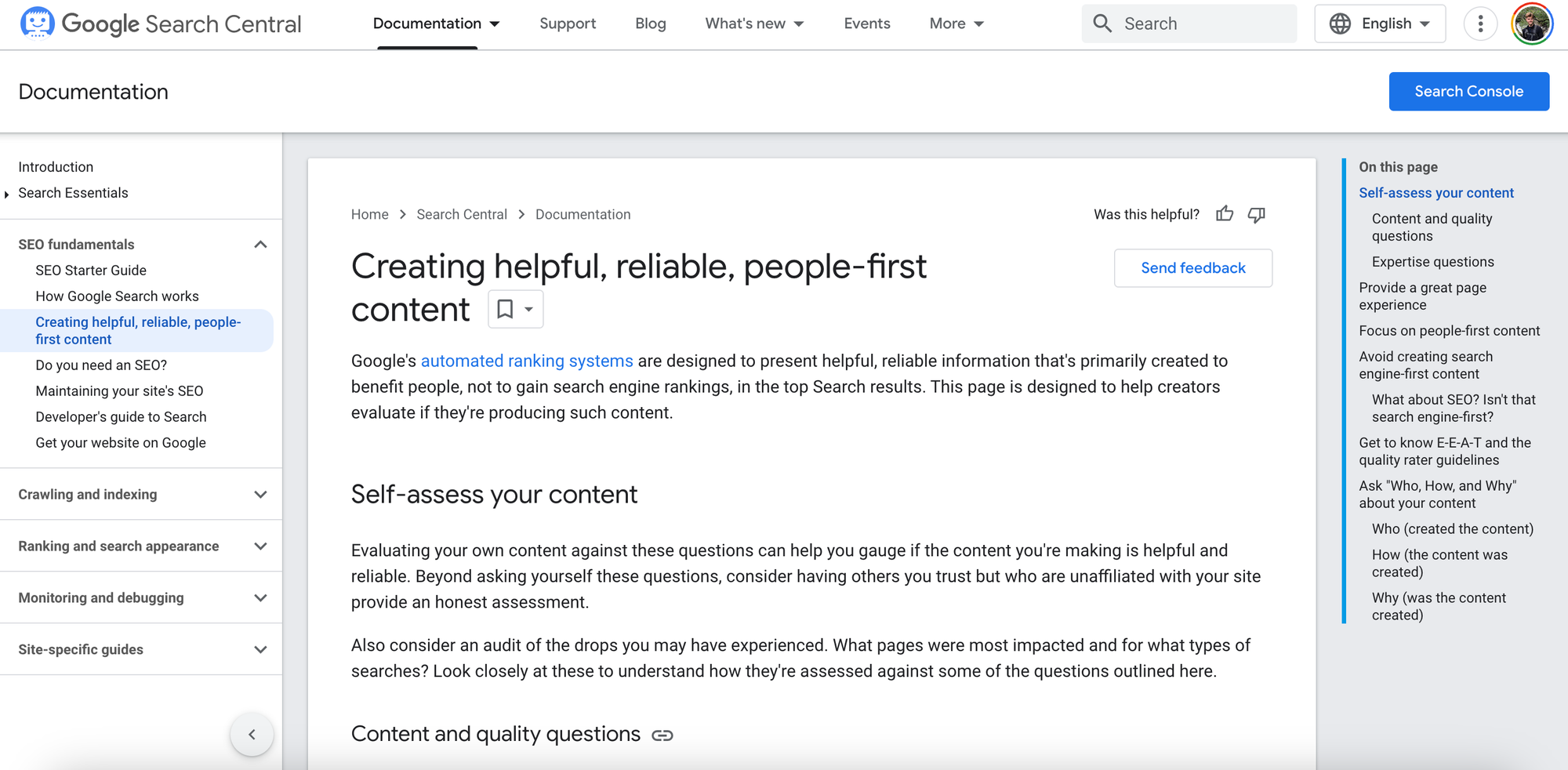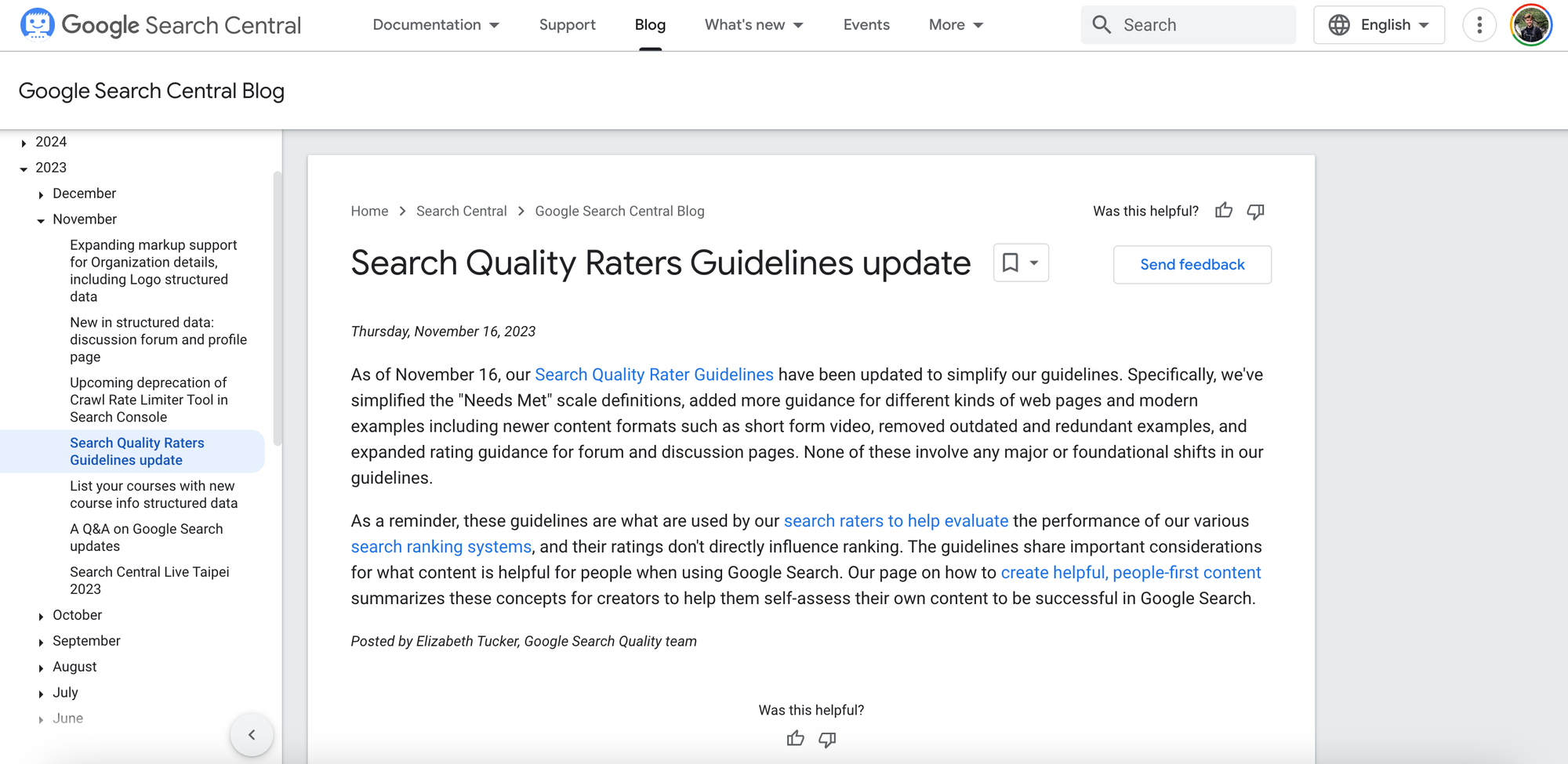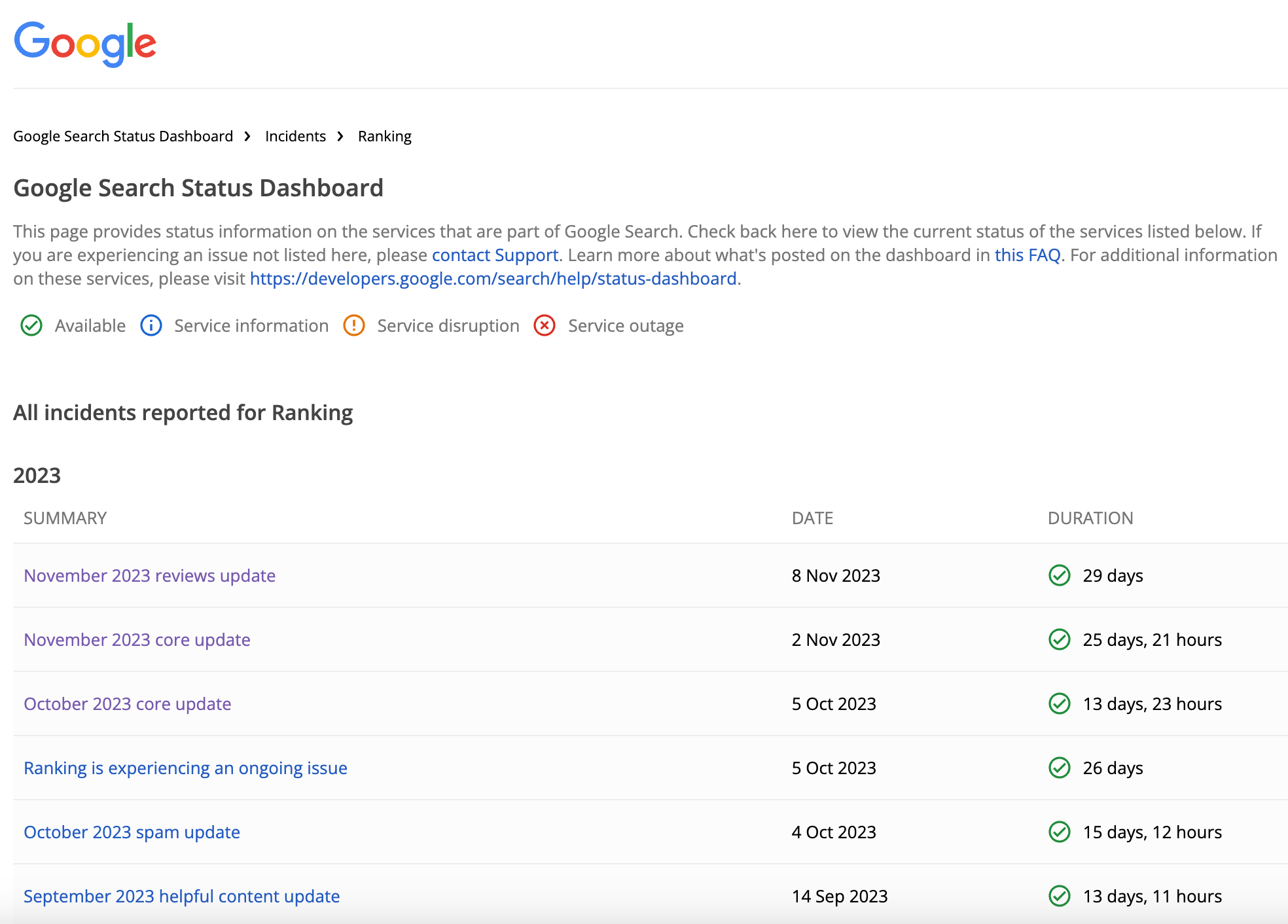Understanding Google’s Ranking Systems makes you a better SEO

As an SEO, or a marketer who’s responsible for SEO performance, it’s important for you to understand Google’s ranking systems.
It will make you a better SEO, improving your ability to manage your core responsibilities:
- Create helpful, reliable content that ranks well
- Analyse the impact of algorithm updates
- Prioritise your SEO roadmap
- Manage your stakeholders.
I’ll run-through how Google uses automated ranking systems to achieve its mission, the purpose of the ranking systems, and why understanding them will help you to succeed with SEO.
Google’s achieves its mission by using automated ranking systems
Google’s mission is to organise the world’s information to make it universally accessible and useful.
In practice, Google aims to present the most relevant and useful search results to the user, and it does this using automated ranking systems that consider many factors and signals in relation to billions of web pages in its search index.

Those automated ranking systems are regularly tested and evaluated (both by humans and AI), which leads to them being updated periodically.
Google’s ranking systems help it to achieve its mission.
Google provides information about their notable ranking systems - both their core ranking systems, and the underlying technologies that produce search results - on their Search Central blog.
If you build familiarity with Google’s ranking systems, you’ll be able to make better SEO decisions, and communicate them more effectively to your stakeholders.
But where do you start? Which ranking systems are the most important to know? And how do you optimise for those ranking systems?
Google’s ranking systems
Google references eighteen different ranking systems on the Search Central blog. That’s a lot of systems. If I group them for you based on how they contribute to Google’s mission, it will help you to understand their purpose.
To understand search query intent to serve relevant search results - Google uses ‘RankBrain’, ‘BERT’, ‘MUM’, ‘Neural matching’, ‘Passage ranking systems’, and ‘Local news system’. A brief summary of each ranking system:
- ‘RankBrain’ is an AI system helping Google to understand how words relate to concepts, and the relationship between concepts.
- ‘BERT’ is an AI system helping Google to understand how different combinations of words express different meanings and intent.
- ‘MUM’ is an AI system that is capable of understanding and generating language (it’s used to improve ‘Featured Snippet’ callouts, not general search rankings).
- ‘Neural matching’ is an AI system that Google uses to understand how concepts are represented in queries and pages to match them to one another.
- ‘Local news systems’ identify local sources of news based on the searcher’s location.
To ensure searchers see helpful, reliable, up-to-date content - Google uses the ‘Helpful content system’ (which has absorbed the ‘Page experience system’), ‘Link analysis systems and PageRank’, ‘Freshness systems’, ‘Original content systems’ and ‘Reviews system’. A brief summary of each ranking system:
- ‘Helpful content system’ ensures people see original, helpful content written for people, by people, in the search results. It also includes ‘Page experience’ signals that reward sites with good UX and page speed.
- ‘Link analysis systems and PageRank’ analyses how pages link to each other and uses this to better understand what a page is about, and if it’s helpful.
- ‘Freshness systems’ are designed to show fresher content for “query deserves freshness” searches.
- ‘Original content systems’ seek to reward content with original research, rather than those that regurgitate pre-existing research.
- ‘Reviews system’ aims to reward high quality reviews, content that provides insightful analysis and original research, and is written by an expert who knows the topic well.
To detect Spam and SERP quality assurance - Google uses its ‘Spam detection systems’, ‘Deduplication systems’, ‘Exact match domain system’, ‘Removal-based demotion systems’ and ‘Site diversity system’. A brief summary of each ranking system:
- ‘Spam detection systems’ (including SpamBrain) are deployed by Google to deal with content and behaviours that violate their spam policies.
- ‘Deduplication systems’ works to only show the most relevant results to avoid unhelpful duplication, and runs to avoid ‘Feature Snippet’ and search result duplication in the same SERP.
- ‘Exact match domain system’ ensures that Google doesn’t give too much credit for content hosted on a domain that exactly matches a particular search query.
- ‘Removal-based demotion systems’ allow Google to remove certain types of content that relate to ‘Legal removals’ and ‘Personal information removals’.
- ‘Site diversity system’ works to ensure Google doesn’t show two results from one site for a search query, unless its intent makes it helpful to do so.
To help during times of crisis - Google uses the ‘Crisis information systems’ to “provide helpful and timely information during times of crisis” which covers ‘Personal crisis’ and ‘SOS alerts’ depending on the scenario.
Now with a deeper understanding of Google’s search systems, we can explore how this can help you successfully manage some core SEO responsibilities, and act as a set of guiding principles for you when planning and executing an SEO strategy.
I’d encourage you to dive deeper into Google’s documentation, independent research and industry expert point of views for each search system to build up your knowledge.
Create helpful, reliable content that ranks well
To create content that ranks well, you need to focus on creating content that meets the requirements of Google’s search systems that ensure searchers see helpful, reliable, up-to-date content. As we’ve covered, those search systems include:
- Helpful content system (which has absorbed the ‘Page experience system’)
- Link analysis systems and PageRank
- Freshness systems
- Original content systems
- Review system.
Helpful content system (including ‘Page experience’)
The ‘Helpful content system’ is arguably the most important search system to consider when creating helpful, reliable content that will rank well.
You can read Google’s guidance in its guide ‘Creating helpful, reliable, people-first content’, where Google outlines how you can self-assess your content in relation to what the ‘Helpful content system’ seeks to reward, including:
- Content and quality questions
- Expertise questions
- Provide a great page experience
- Focus on people-first content
- Avoid creating search-engine first content
- Get to know E-E-A-T and the quality rater guidelines
- Ask “Who, How, and Why” about your content.

Google’s ‘Helpful content system’ analyses a mix of ranking signals to determine which content is the most helpful for the searcher by considering how it demonstrates experience, expertise, authoritativeness and trustworthiness (E-E-A-T). That’s why in recent years, the interest in E-E-A-T and how to optimise for it has grown in the SEO community.
E-E-A-T is the framework that Google references in its ‘Search Quality Rater Guidelines’ (SQRG). The SQRG is used by Google’s human search quality raters who are trained to evaluate the E-E-A-T of search results. The human search quality raters then give Google insights on if their algorithms are providing good results, and this ‘human in the loop’ feedback is used to train their automated ranking systems, like the ‘Helpful content system’.
You should read Google’s ‘Search Quality Rater Guidelines’ (SQRG) to understand how human search quality raters score search results based on ‘Needs Met’ and ‘Quality’ scores in relation to the search query, and how they consider E-E-A-T when doing this. Integrate the same auditing processes Google’s human quality raters do into your optimisation work streams.

Google’s ‘Helpful content system’ absorbed its ‘Page experience system’ in 2023, meaning that as Google evaluates content quality in relation to the searchers query, it will consider your page’s Core Web Vitals scores, page speed and the overall user experience as indicators of helpful content.
Google has documentation on ‘Understanding page experience in Google search results’ for you to understand which questions you should ask when optimising your content for Page Experience.
To succeed in creating helpful, reliable content that will rank well you should align your content planning, creation and optimisation work streams with the questions Google states that its ‘Helpful content system’ seeks to reward.
This will give you a set of SEO principles to follow when creating or auditing content on your website. It will also encourage you to optimise your content for Core Web Vitals, page speed and UX, rather than focusing too heavily on basic ranking signals, such as keywords and backlinks.
A note on E-E-A-T: It’s not a Ranking Signal, as clearly stated by Google in their SEO Starter guide. However, it acts as a set of guiding principles helping you to create helpful, reliable content for people, by people, that the Helpful content system seeks to reward.
Link analysis systems and PageRank
Google’s ‘Link analysis systems and PageRank’ are some of its oldest search systems, although they have been updated many times. PageRank is a core ranking system that was around when Google first launched.
Backlinks continue to be an important ingredient in the recipe for SEO success. They tell Google what a page is about, how that page relates to a topic or concept, and its relationship to other pages in Google’s search index.
They act as ranking signals, and are still worth optimising for. You should consider both how you can create content that naturally acquires backlinks from the open web, content you can promote to generate backlinks from external websites and also how you internally link between your content to build topic clusters.
If your content is acquiring fresh, high quality, relevant backlinks it’s a signal to Google that your content is authoritative, which is a key part of the E-E-A-T optimisation framework. Invest time into optimising for ‘Link analysis systems and PageRank’ for improved rankings.
Freshness systems
Google states in their ‘Freshness systems’ documentation that some search queries are ‘Query deserves freshness’ and this means that if you’re trying to rank for queries where the user intent implies it’s ‘Query deserves freshness’ then you’ll need to create relevant, timely content that’s related to the keyword, topic or concept.
It’s also important to remember that Google also rewards content freshness for all search queries.
Knowing this, it’s beneficial for you to allocate a significant proportion of your content resources towards historical optimisation of existing content to optimise for the ‘Freshness systems’. If you don’t, your competitors will. It’s also worth pointing out that more up-to-date content is more helpful for the searcher, which aligns with what the ‘Helpful content system’ seeks to reward.
Original content systems
Google has systems that ensure original content is shown prominently in the search results, known as the ‘Original content systems’.
I would recommend expanding your content creation capabilities to be able to produce primary research if possible. You could do this by sending surveys to your customers, or using an agency to run polls. You can tailor your survey to add original angles to your content, differentiating it from the competition.
Google is then likely to reward that content with better rankings.
There is a technical SEO component to this too and that is making sure you correctly use canonical tags to tell Google which URL is the original if there is any duplication on your website. Duplicate content can lead to cannibalisation and a number of other issues relating to crawling and indexation.
Reviews system
The Reviews system takes into account various factors to ensure that users receive the most helpful and trustworthy information when making decisions about businesses.
Key components of the Reviews Ranking System include:
- Review content: Google assesses the content of reviews, looking for relevance, depth, and usefulness. Reviews that provide detailed insights into the customer experience are typically ranked higher
- Reviewer credibility: The credibility of the reviewer is taken into consideration, including factors such as their review history, activity level, and whether they are verified customers
- Sentiment analysis: Google employs sentiment analysis techniques to understand the tone and sentiment of reviews, distinguishing between positive and negative feedback
- Recency: Freshness of reviews is also a factor, with more recent reviews often carrying more weight in the ranking.
Analyse the impact of algorithm updates
To successfully analyse the impact of an algorithm update to the point where you have confidence in your hypotheses as to why your website has experienced positive or negative ranking changes, you should consider Google’s search systems and their official announcements of what each algorithm update focused on.

Some examples of Google algorithm updates, and the search systems they focused on, include:
- Core updates (a broad update that considers all search systems)
- Helpful content updates (an update relating to the “Helpful content search system”)
- Reviews updates (an update relating to the “Reviews search system”)
- Link spam updates (an update relating to the “Link spam search system”)
You should analyse your historical Organic Search performance data in a platform like Google Analytics, and cross-reference that data with a historical timeline of confirmed (and unconfirmed) algorithm updates from Google.
Refer to Google’s announcements on which search systems an algorithm update focused on, and check whether your website benefited or fell in line with the update roll-out timeline. This will give you insights that help you to build your hypotheses, and focus your analysis on a specific set of ranking signals, or SEO principles, for your website and competitors for those search query SERPs exhibiting ranking shifts.
By diagnosing which search systems and their relevant signals are impacting your website’s performance, you’ll be able to prioritise your SEO roadmap to optimise for a search system, or group of search systems, that you’re confident will deliver results.
Prioritise your SEO roadmap
The reality of SEO is that there is always more you can do to improve the performance of your website to generate more traffic and conversations.
However, you will always be limited by the budget and resources you have available.
It’s imperative that you have a logical system for building and validating how you’re prioritising your SEO roadmap. You can use your understanding of Google’s search systems to your advantage here.
We’ve covered how you can diagnose issues on your website by cross-referencing algorithm updates, the search systems they focus on, and your Organic Search performance data to spot areas for optimisation.
You should also consider the signals that each Google search system seeks to reward or demote, and align your SEO roadmap towards optimising for those signals.
An example would be how in 2023, there were a number of Google update announcements and industry chatter that stressed the increasing importance of the role of the ‘Helpful content search system’ in ranking results, and the E-E-A-T framework for marketers to consider.
In this situation, you would benefit from revising what Google seeks to reward through their ‘Helpful content search system’ to tailor your SEO roadmap to cater for these new signals. For instance, by increasing your investment in original research, hiring subject matter experts, or refreshing your content with up-to-date statistics and references.
Another example would be from March 2023’s core algorithm update, where Google integrated the ‘Page Experience search system’ into their ‘Helpful Content search system’ and industry chatter suggested the update focused on rewarding websites and pages with good Core Web Vitals and page speed scores. In this instance, you would consider how much investment and buy-in you had planned for improving Core Web Vitals and reprioritise as needed to move the needle.
Manage your stakeholders
SEO is a complicated field of marketing, and one of the toughest challenges is communicating clearly to your stakeholders why you have prioritised the SEO roadmap the way that you have, and then using that to generate buy-in in line with those priorities.
I highly recommend referencing Google’s official documentation and nomenclature around its search systems when communicating with your stakeholders.
From my experience, you’ll often be collaborating with stakeholders that take these broad positions on SEO:
- I do understand SEO, and I’m willing to collaborate (a.k.a provide resources, budget and support)
- I do understand SEO, and I’m going to challenge you to provide clear reasoning to explain why it’s a priority vs. other investments
- I don’t understand SEO, and I’m willing to collaborate (a.k.a provide resources, budget and support)
- I don’t understand SEO, and I’m going to confront you on why it’s a priority vs. other investments.
If you’re working with stakeholders who will either challenge you to provide clear reasoning, or confront you, on why it’s a priority versus other work streams or investments then you should refer to specific search systems, and lean on Google’s official documentation to generate buy-in.
Google maintains a resource that lists all of the algorithm updates and the roll-out dates. You can refer to this when communicating to stakeholders to explain your reasoning, citing the relevant search systems and mapping them to the ranking signals your SEO roadmap is optimising for.
Understanding Google’s search systems makes you a better SEO
As you’ll have seen from what we’ve covered, a deep understanding of Google’s search systems makes you a better SEO.
Your knowledge of the search systems will help you build your SEO principles for creating helpful, reliable content, analysing algorithm updates with confidence and clarity, prioritising your SEO roadmap based on the signals the search systems seek to reward or demote, and communicating the ‘why’ to stakeholders to generate buy-in.
Finally, I recommend that you refer back to Google’s search systems documentation regularly, as it changes and you’ll want to stay up-to-date.
Subscribe to learn more about the latest marketing strategies & tactics, platform updates and MarTech news. I’ll share what matters, and how you can plan accordingly. ✌
Rory Hope Newsletter
Join the newsletter to receive the latest updates in your inbox.
